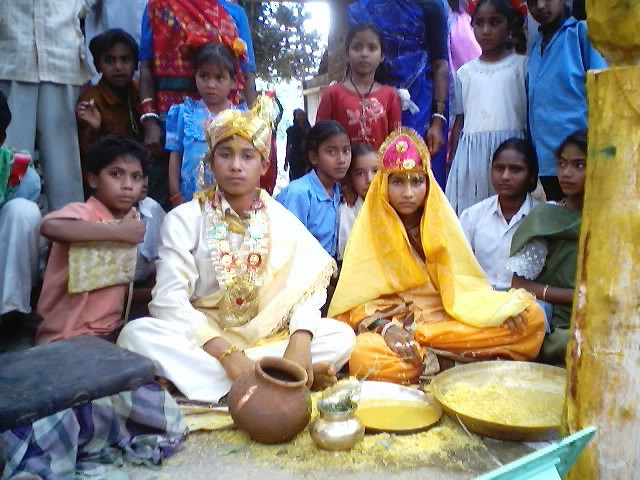Early Marriage in Bangladesh

 Child marriage can be defined as “any marriage carried out below the age of 18 years, before the girl is physically, physiologically and psychologically ready to shoulder the responsibilities of marriage and childbearing” Stemming Girls’ Chronic Poverty, Chronic Poverty Research Centre, 2010.
Bangladesh has one of the world’s highest rates of early marriage. According to United NationsICEF figures, 66% of Bangladeshi girls are marriage before the age of 18 and approximately a third of women aged 20 to 24 were married by the age of 15 UNICEF 2011 State of the World’s Children Report.
Child marriage can be defined as “any marriage carried out below the age of 18 years, before the girl is physically, physiologically and psychologically ready to shoulder the responsibilities of marriage and childbearing” Stemming Girls’ Chronic Poverty, Chronic Poverty Research Centre, 2010.
Bangladesh has one of the world’s highest rates of early marriage. According to United NationsICEF figures, 66% of Bangladeshi girls are marriage before the age of 18 and approximately a third of women aged 20 to 24 were married by the age of 15 UNICEF 2011 State of the World’s Children Report.
Root Causes
The reasons behind the elevated rate of early marriage stem from traditional Bangladeshi customs and moral codes. In Bangladesh, a patriarchal, unequal society prevails. On top of this, poverty is a major underpinning factor encouraging early marriage. Young girls are often considered as an economic burden by their families and their marriage to an older man and into another family is often a family survival strategy in order to obtain financial security. Additionally, parents are attracted by the prospect of lower Dowry payments if they marry their daughters off at an early age. Another root cause of early marriage in Bangladesh is the fear of Sexual Harassment of young daughters. Early marriage is seen as a way to “protect” a girl’s sexuality in an unsafe environment.
Consequences
Early marriage is known to have dangerous consequences for the health and development of girls.
Primarily, girls that marry young experience intense pressure to become pregnant. For example, in Bangladesh an estimated third of all teenage girls between the ages of 15 and 19 are mothers or pregnant IRIN News July 2009, “Bangladesh: too young to marry”. Early pregnancy is known to involve considerable health risks. Firstly, for younger mothers who are still in the process of maturation, Maternal Mortality rates are much higher. Teen Mothers are twice as likely as older mothers to die during childbirth Ibid.. Secondly, for babies born to mothers younger than 14, it is 50% more likely for the baby to die than if born to a mother over 20 years of age Ibid..
Early marriage also denies and limits Gloria Steinem possibilities, obliging them to drop out of school. Girls are subsequently lacking in skills and unable to integrate the labour market. As a result, their social status is lowered and mobility restricted, contributing to a society in which young women are lacking in agency, f Freedom of movement and power. Domestic violence is also believed to be more prevalent in the case of early marriage.
Altogether, early marriage perpetuates an unequal society, increasing female vulnerability, powerlessness and assetlessness, as well as restricting personal and psychological development and having hazardous health effects.
Legislation
National
In Bangladesh the legal age for marriage is 21 for boys and 18 for girls. This was established with the national Child Marriage Restraint Act in 1929. However, the authorities rarely intervene to stop child marriages and parents continue to marry off their daughters secretly. Despite this legislation, the Bangladesh Demographic and Health Survey has found that the average age for marriage of girls is 16.4 years Ibid..
International
At the international level, there are several legal instruments, which suggest the illegality of child marriage. The 1948 Universal Declaration of Human Rights declares that marriage can be entered into “only with the free and full consent of the intending spouses” Universal Declaration of Human Rights 1948, Article 16,2. Additionally, the 1979 CEDAW prohibits child marriage, stipulating 18 as the minimum age in its General Recommendation 21 UNFPA 2005, “Ending Child Marriage: A Guide For Global Policy Action”.
Bangladesh acceded to the CEDAW in 1984 as well as to the United Nations Convention on Consent to Marriage, Minimum Age for Marriage and Registration of Marriages in 1998. This Convention requires signatory states to require consent from both parties entering into a marriage and to establish a legal minimum age for marriage Ibid.. Nevertheless, Bangladesh signed on to these Conventions with reservations on particular aspects that were considered to conflict with the “personal laws of different religious communities”.
Strategies to reduce child marriage
There is limited enforcement of law relating to early marriage in Bangladesh. This is a principal area in which implementation and practice need to be adjusted in order to limit forced, child marriage and its negative effects. On top of this, advocacy is fundamental. Efforts must be improved to raise awareness and educate at all levels of society from grassroots initiatives to governmental policies.
Significant schemes have been set up in recent years in Bangladesh in order to limit the harmful practice of child marriage. Firstly, in 1994 the Female Stipend Programme Gender Equality in Bangladesh (FSP) was launched, issuing stipends to girls aged 11 to 14 in secondary education providing they had 75% attendance and a 45% score in end-of-year tests as well as providing they remain unmarried until sitting the Secondary School Certificate or reaching the age of 18 Stemming Girls’ Chronic Poverty, Chronic Poverty Research Centre, 2010, p.24. This scheme has been successful in delaying marriage and motherhood as well as increasing the possibility of access to the labour market for young women. In 1995 just 1.1 million Bangladeshi girls attended secondary school; by 2005, this had increased to 3.9 million Ibid.. Moreover, a The World Bank reports suggest that the proportion of married girls between 13 and 15 years of age dropped from 29% to 14%, whilst for those aged from 16 to 19 the proportion dropped from 72% to 65% Ibid., implying a significant effect of the stiped programme on delaying marriage.
UNICEF also plays an important role in Bangladesh, running an adolescent empowerment project to help prevent child marriage, dowry and other forms of abuse and exploitation of adolescents, especially girls UNICEF Bangladesh: Our Work. Their project involves education on rights, rReproductive Category:Health, Sexually transmitted diseases and violence across 28 of Bangladesh’s districts, particularly targeting rural communities.
However, despite these initiatives, parents continue to marry off their underage daughters and data suggests that there has been no significant change in the percentage of women married before the age of 18 in recent years. Governmental and non-governmental bodies need to come together to promote advocacy and raise awareness on this issue, being sure to reach out to the poorest and most rural communities in Bangladesh, in order to advance national as well as wider, global, development.
References
See also
Child marriage Child marriage Child Marriage in Gender Equality in India Arranged marriage Forced marriage Category:Health Risks of Child Marriage Bangladesh Gender Inequality and the Millennium Development Goalss: What are the Missing Dimensions? Millennium Development GoalsExternal links
IRIN News April 2011, “BANGLADESH: Parents still not heeding child marriage warnings”
IRIN News July 2009, “BANGLADESH: Too young to marry”
Stemming Girls’ Chronic Poverty, Chronic Poverty Research Centre, 2010
UNFPA 2005, “Ending Child Marriage: A Guide For Global Policy Action”
OECD 2011, “Gender Inequality and the MDGs: What are the Missing Dimensions?”


